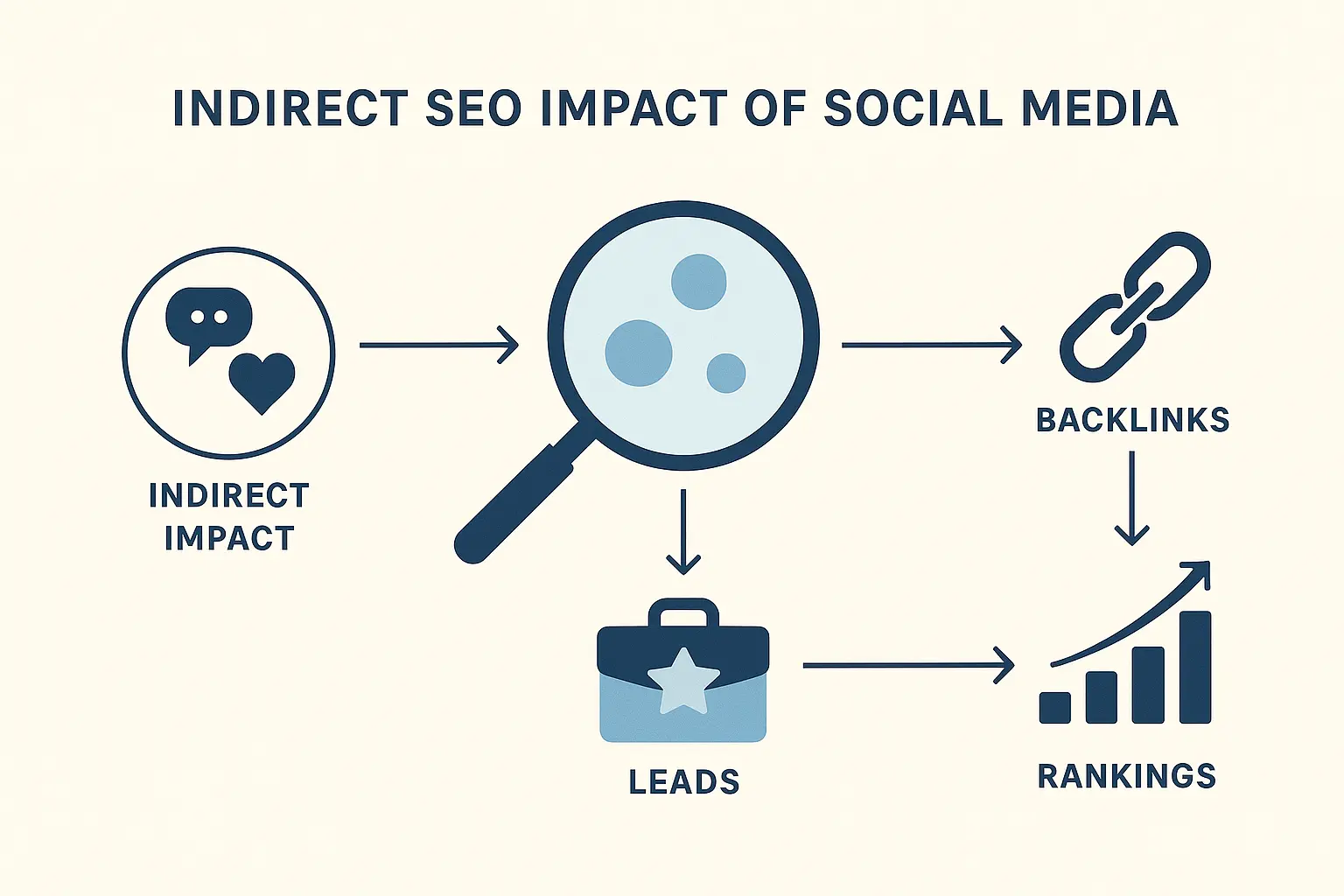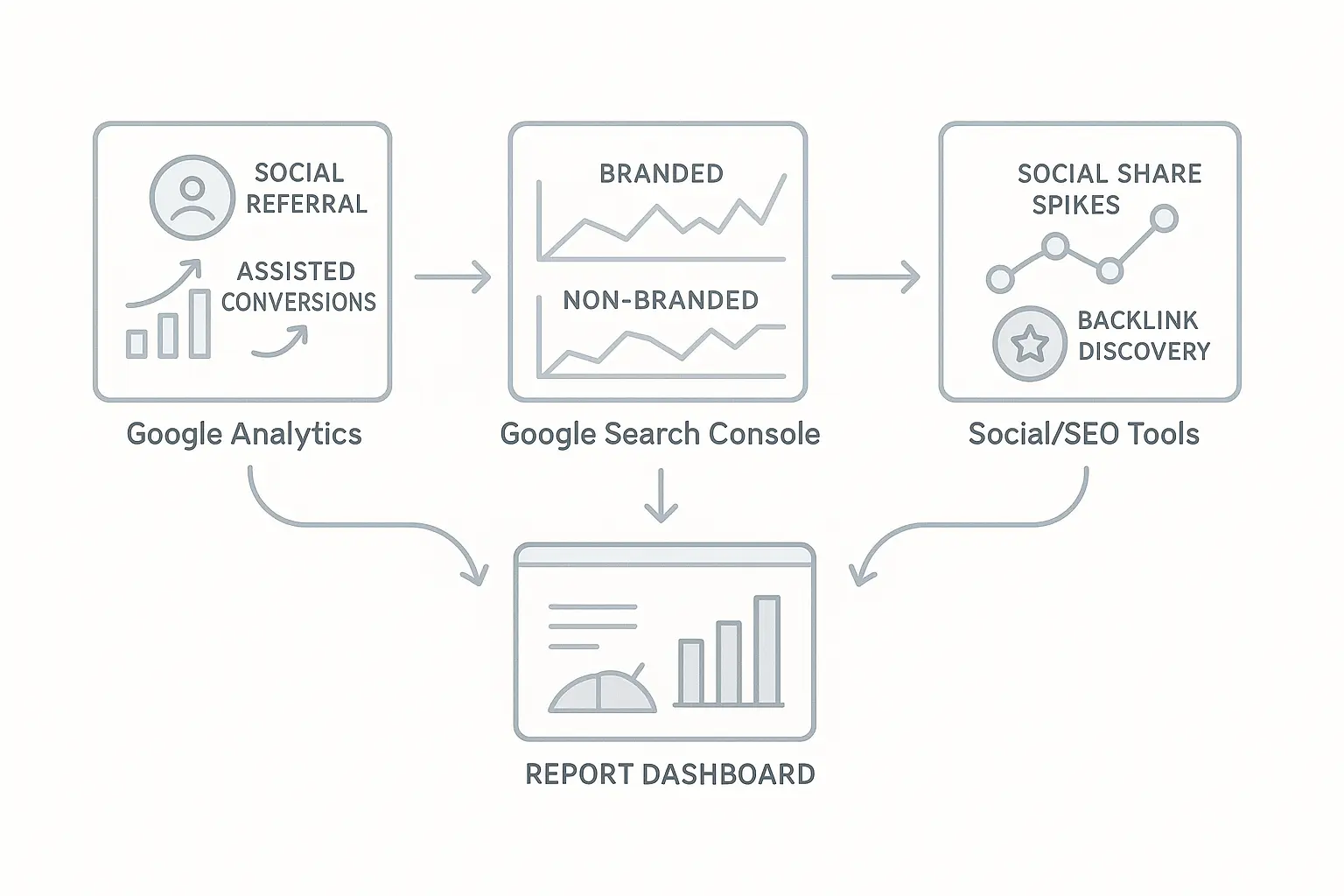You’re in the quarterly review meeting. The client is happy with your SEO progress—rankings are up, organic traffic is climbing. Then you switch to the social media report.
“The engagement on that last Instagram reel was fantastic,” you say, pointing to a chart filled with likes, shares, and comments.
Your client leans back, arms crossed. “That’s great,” they say, “but what does it actually do? How do a thousand likes in Chicago help us rank higher for ‘industrial supply services’ in Houston?”
If you’ve ever felt a bead of sweat trickle down your back in that moment, you’re not alone. For many agencies, connecting the dots between a vibrant social media presence and hard SEO results remains one of the toughest stories to tell.
Clients often see them as two separate worlds: SEO is the technical science of keywords and backlinks, while social is the fluffy art of brand awareness.
The problem is, that view is about a decade out of date. In today’s digital ecosystem, search engines and social platforms are in a constant conversation. Your job is to translate that dialogue into the language your clients understand: revenue.
The Great Disconnect: Why Clients Separate Social Media and SEO
Historically, the two disciplines operated in silos. SEO professionals focused on crawling, indexing, and on-page optimization, while social media managers were busy with community building and content calendars. Their metrics rarely overlapped, leading to a natural and understandable division in the minds of clients.
But search engines have evolved. They’re no longer just directories of websites; they are complex “answer engines” trying to understand a brand’s real-world authority and relevance. They use a wide range of signals to determine which brands are trustworthy, and many of those signals originate far from your website itself.
Think of it like this: if ten different people at a party are all talking about a new restaurant, you’re more likely to believe it’s a great place to eat. Search engines apply the same logic. They see conversations, shares, and brand mentions on social platforms as a proxy for real-world buzz.
The research backs this up, consistently finding a strong correlation between high social engagement and higher search rankings, especially for competitive terms. It’s not about the “like” itself; it’s about what that collective engagement represents: authority, trust, and relevance.
Shifting the Conversation: From Social Signals to Business Impact
To get client buy-in, you have to stop reporting on social activity and start reporting on business impact. The key is to frame social engagement not as the end goal, but as the catalyst for tangible SEO outcomes.
Here are three specific, reportable narratives that connect the dots for even the most skeptical clients.
1. The Ripple Effect: How Social Amplification Fuels Link Building
Your client is right—a “like” isn’t a backlink. But a post that gets a thousand likes and hundreds of shares creates ripples that often lead to backlinks.
When a piece of content—a clever infographic, a compelling video, a data-driven report—goes viral on a platform like LinkedIn or Twitter, it gets seen by journalists, industry bloggers, and content creators looking for sources. They see the content, find it valuable, and reference it in their own articles, linking back to your client’s site as the original source.
This is the holy grail of modern link building: earning high-quality, editorially-given links without direct outreach. Social media is the amplification engine that makes it possible.
How to Report It:
Instead of just showing shares, track new referring domains in the weeks following a successful social campaign.
Narrative: “Our LinkedIn post on Q3 manufacturing trends reached over 50,000 professionals. In the two weeks that followed, it was cited by three major industry blogs, earning us powerful backlinks that directly contributed to our 15% ranking improvement for ‘custom parts manufacturing.’”
2. From Likes to Lookups: Tracking Branded Search Growth
What happens when you see a fascinating video from a brand you’ve never heard of? You probably don’t click the link in their bio. You open a new tab and Google them.
This behavior—branded search—is one of the most powerful trust signals you can send to Google. When Google sees a sudden and sustained increase in people searching for your client’s brand name, it interprets it as a sign of growing authority and relevance. Why? Because real, popular brands get searched for by name.
A successful social media strategy, especially on discovery platforms like TikTok and Instagram, directly fuels this behavior. It plants a seed of curiosity that blossoms in the Google search bar. This proves you’re not just managing a social account; you’re building a brand that people actively seek out.
How to Report It:
Use Google Search Console’s performance data. Overlay your social campaign timeline with the graph showing queries for your client’s brand name.
Narrative: “Following the launch of our ‘Behind the Scenes’ video series on Instagram in May, which garnered over 200,000 views, we saw a 45% increase in branded search volume. This tells us the campaign didn’t just earn engagement; it made our brand memorable and drove qualified, high-intent traffic directly to our site.”
3. Closing the Loop: Connecting Social Traffic to Conversions
The final piece of the puzzle is tying social activity to bottom-line results like leads and sales. This can be tricky because the customer journey is rarely linear. A user might see a post on Facebook, visit the site, leave, see a retargeting ad, search the brand name a week later, and then finally convert.
Standard last-click attribution would give all the credit to organic search, completely ignoring the crucial first touchpoint on social media. This is where assisted conversion reports in Google Analytics (or GA4’s model comparison tool) become your best friend. These reports show you which channels played a role along the path to conversion, not just the final one.
How to Report It:
Focus on assisted conversions to show how social media is opening loops that other channels are closing.
Narrative: “While organic search was the final click for 30 new leads last month, our analytics show that social media ‘assisted’ in 12 of those conversions. This means our social content was a critical early touchpoint that introduced these future customers to our brand, teeing them up for our sales team.”
Building the Report: A Template for Skeptical Clients
Don’t just present data; tell a story. Structure your report to walk the client from the initial social activity to the final business outcome.
Section 1: The Social Spark (The Input)
What to show: Highlight the top-performing posts of the month.
Metrics: Reach, Engagement Rate, Shares, Video Views.
Narrative: “This was the content that captured attention and started the conversation.”

Section 2: The SEO Echo (The Outcome)
What to show: Connect the “Spark” to tangible SEO results.
Metrics & Narrative 1 (Authority): New Referring Domains. “Our viral post led to these high-value backlinks.”
Metrics & Narrative 2 (Relevance): Branded Search Growth. “That attention translated into a 45% lift in people searching for us by name.”
Metrics & Narrative 3 (Revenue): Assisted Conversions. “Our social presence influenced $15,000 in new sales, even when it wasn’t the final click.”

FAQs: Answering the Tough Questions
Q: Are social shares a direct Google ranking factor?
A: This is a classic question. While Google has been cagey, the consensus is that social links and shares are not treated the same as a traditional backlink. However, the correlation is undeniable. High social activity leads to the things that are direct ranking factors: backlinks, brand mentions, and increased branded search. Think of social as the cause and the SEO benefits as the effect.
Q: How long does it take to see the SEO impact of social media?
A: It’s not immediate. The ripple effect takes time. Branded search lift can often be seen within weeks of a successful campaign. Backlinks might take longer as journalists and bloggers discover the content. It’s a long-term strategy that builds momentum over time, not an overnight fix.
Q: What if we don’t get any backlinks from our social posts?
A: That’s okay. Link building is only one piece of the puzzle. The impact on branded search and assisted conversions is often more immediate and just as valuable. If you can show that your social efforts are making more people search for the client by name, you’re already proving immense value.
Q: Which social platform is best for SEO?
A: The one where your client’s audience is most active and where content is most likely to be shared by influencers in their space. For a B2B client, a data-rich post on LinkedIn might generate backlinks from industry publications. For a B2C e-commerce brand, a viral TikTok could drive a massive spike in branded search. The strategy must fit the audience.
The Future is Omnichannel
Telling the story of social’s impact on SEO isn’t just about justifying a budget; it’s about educating your clients on the reality of modern marketing. Success no longer happens in isolated channels. It happens at the intersection of search, social, content, and brand.

By mastering this narrative, you move from being a service provider who reports on metrics to a strategic partner who builds an interconnected growth engine. You show clients that every piece of the strategy works together, creating a whole that is far greater than the sum of its parts. This holistic perspective is the core of a modern growth strategy, where every channel amplifies the others to drive measurable business results.

